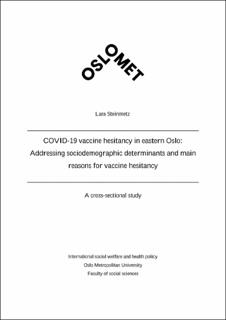| dc.description.abstract | Background: Vaccines are an essential public health strategy to curb viral infection
spreading and hinge on vaccine uptake which may be threatened by vaccine hesitant
individuals. This study therefore aims to address sociodemographic predictors of vaccine
hesitancy, main reasons for vaccine hesitancy, and how these reasons are explained by
sociodemographic characteristics during the COVID-19 pandemic.
Methods: A cross-sectional study (N = 5442) was carried out in June 2021 among six eastern
Oslo districts with high infection pressure. Sociodemographic variables included gender, age,
country of birth, education, and household income. Binary logistic regression models were
used to explore predictors of both vaccine hesitancy and specific reasons. Main reasons for
vaccine hesitancy were assessed through descriptive statistics.
Results: Vaccine hesitancy was overall low (5.8%). Findings stress the vulnerable position of
younger age, participants born outside of Norway, lower education, and lower household
income in relation to vaccine hesitancy proneness. Hesitancy was mainly grounded in
confidence barriers such as fear of side effects (55.8%) and little experience with the vaccines
(50.2%). Otherwise, complacency barriers such as not feeling to belong to a risk group
(46.1%), not needing the vaccines (39.1%), and wanting the body to develop natural
immunity (29.3%) were frequently present. Results indicated overall high trust in health
authorities and professionals. Women and participants born in Norway were more likely
hesitant due to a lack of confidence in the vaccines. Complacency barriers were less likely
present among older age (60+) and participants born outside of Norway.
Conclusions: Varying determinants of vaccine hesitancy and barrier trends among
population groups emphasize the importance of clear public health communication about the
risks, benefits, and importance of vaccines. Future studies with a larger sample should verify
current findings and further explore the prevalence of convenience barriers. Norwegian health
authorities should take these results into account and develop different public health strategies
targeted at vulnerable population groups during the current and forthcoming pandemics to
increase vaccine uptake and reach sufficient immunization. | en_US |
